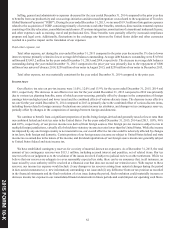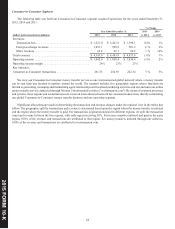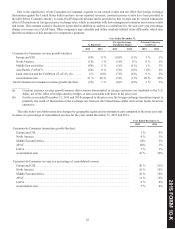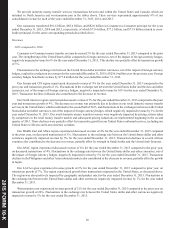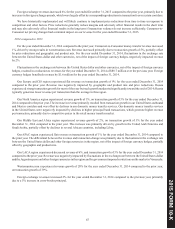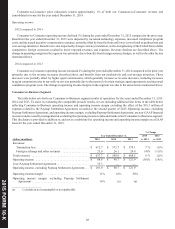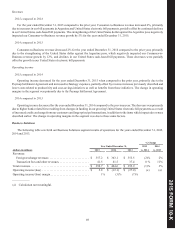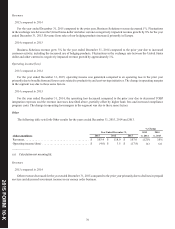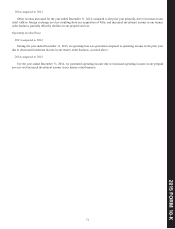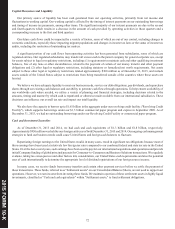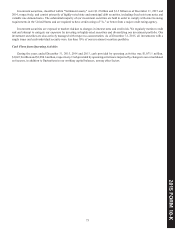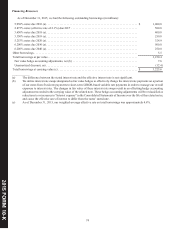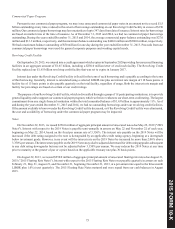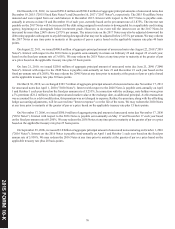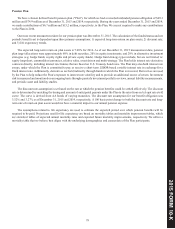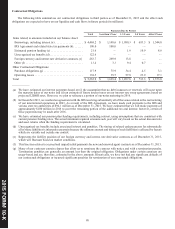Western Union 2015 Annual Report Download - page 174
Download and view the complete annual report
Please find page 174 of the 2015 Western Union annual report below. You can navigate through the pages in the report by either clicking on the pages listed below, or by using the keyword search tool below to find specific information within the annual report.
72
Capital Resources and Liquidity
Our primary source of liquidity has been cash generated from our operating activities, primarily from net income and
fluctuations in working capital. Our working capital is affected by the timing of interest payments on our outstanding borrowings
and timing of income tax payments, among other items. The significant majority of our interest payments are due in the second
and fourth quarters which results in a decrease in the amount of cash provided by operating activities in those quarters and a
corresponding increase to the first and third quarters.
Our future cash flows could be impacted by a variety of factors, some of which are out of our control, including changes in
economic conditions, especially those impacting migrant populations and changes in income tax laws or the status of income tax
audits, including the resolution of outstanding tax matters.
A significant portion of our cash flows from operating activities has been generated from subsidiaries, some of which are
regulated entities. Our regulated subsidiaries may transfer all excess cash to the parent company for general corporate use, except
for assets subject to legal or regulatory restrictions, including: (1) requirements to maintain cash and other qualifying investment
balances, free of any liens or other encumbrances, related to the payment of certain of our money transfer and other payment
obligations and (2) other legal or regulatory restrictions, including statutory or formalized net worth requirements. Net assets
subject to these other legal or regulatory restrictions totaled approximately $300 million as of December 31, 2015, and include
assets outside of the United States subject to restrictions from being transferred outside of the countries where these assets are
located.
We believe we have adequate liquidity to meet our business needs, service our debt obligations, pay dividends, and repurchase
shares through our existing cash balances and our ability to generate cash flows through operations. To help ensure availability of
our worldwide cash where needed, we utilize a variety of planning and financial strategies, including decisions related to the
amounts, timing and manner by which cash is repatriated or otherwise made available from our international subsidiaries. These
decisions can influence our overall tax rate and impact our total liquidity.
We also have the capacity to borrow up to $1.65 billion in the aggregate under our revolving credit facility ("Revolving Credit
Facility"), which supports borrowings under our $1.5 billion commercial paper program and expires in September 2020. As of
December 31, 2015, we had no outstanding borrowings under our Revolving Credit Facility or commercial paper program.
Cash and Investment Securities
As of December 31, 2015 and 2014, we had cash and cash equivalents of $1.3 billion and $1.8 billion, respectively.
Approximately $950 million was held by our foreign entities as of both December 31, 2015 and 2014. Our ongoing cash management
strategies to fund our business needs could cause United States and foreign cash balances to fluctuate.
Repatriating foreign earnings to the United States would, in many cases, result in significant tax obligations because most of
these earnings have been taxed at relatively low foreign tax rates compared to our combined federal and state tax rate in the United
States. Over the last several years, such earnings have been used to pay for our international acquisitions and operations and provide
initial Company funding of global principal payouts for Consumer-to-Consumer and Business Solutions transactions. We regularly
evaluate, taking tax consequences and other factors into consideration, our United States cash requirements and also the potential
uses of cash internationally to determine the appropriate level of dividend repatriations of our foreign source income.
In many cases, we receive funds from money transfers and certain other payment services before we settle the payment of
those transactions. These funds, referred to as "Settlement assets" on our Consolidated Balance Sheets, are not used to support our
operations. However, we earn income from investing these funds. We maintain a portion of these settlement assets in highly liquid
investments, classified as "Cash and cash equivalents" within "Settlement assets," to fund settlement obligations.
201 FORM 10-K
5


